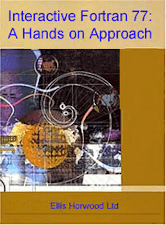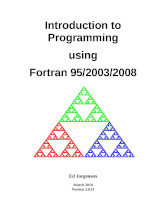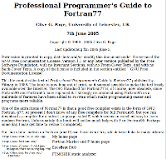Last Updated on December 19, 2024
Fortran (Formula translation) is a multi-paradigm programming language invented by John Backus of IBM in the 1950s. It is particularly notable for innovation; it was the first high-level language, using the first compiler.
The language is designed to be simple to understand, yet retains the efficiency in execution as assembly language – about 80% as efficient as assembly/machine code. Fortran is machine independent, and a problem oriented language. It is often used in the scientific community, particularly among physicists, and is designed for scientific numerical computing. Fortran allows for high parallelization, it’s easy to optimize, and lends itself particularly well to computationally intensive fields such as finite element analysis, numerical weather prediction, computational physics, computational chemistry, and computational fluid dynamics.
Fortran has evolved over time, with various standards including Fortran IV, Fortran 77, Fortran 90 and Fortran 95. More recent revisions are Fortran 2003, and Fortran 2008. Since Fortran 9x, it has many structured programming features, dynamic memory, operator overloading, and primitive objects. It is both the language of the past, the current, and the future (high-performance computing is unlikely to cast aside Fortran). Despite its age, Fortran is still very much alive and kicking. Fortran has a vast number of libraries of code.
Here’s our recommended books to master Fortran.
1. Interactive Fortran 77: A Hands on Approach by Ian D Chivers, Jane Sleightholme
 Interactive Fortran 77: A Hands on Approach introduces the reader to the concepts and ideas involved in problem solving with Fortran 77.
Interactive Fortran 77: A Hands on Approach introduces the reader to the concepts and ideas involved in problem solving with Fortran 77.
The authors stress the first stages of good programming practice, the accurate specification of problems, and well-organized program plans. Once these principles are defined, the main features of Fortran 77 are introduced. The emphasis throughout is placed on the need for a rigorous approach to algorithmic problem-solving, and the practical benefits to be gained from the adoption of a structured modular methodology.
2. Introduction to Programming using Fortran 95/2003/2008 by Ed Jorgensen
 Introduction to Programming using Fortran 95/2003/2008 provides an introduction to programming and problem solving using the Fortran 95/2003/2008 programming language.
Introduction to Programming using Fortran 95/2003/2008 provides an introduction to programming and problem solving using the Fortran 95/2003/2008 programming language.
This introduction is geared for non computer science majors. As such, this text is not a complete, comprehensive guide to the Fortran 95/2003/2008 programming language.
The primary focus is on an introduction to problem solving and algorithm development. As such, many details of the Fortran 95/2203/2008 language are omitted.
3. Professional Programmer’s Guide to Fortran77 by Clive G. Page
 Professional Programmers Guide To Fortran 77 provides a comprehensive description of the features and implementation of Fortran 77.
Professional Programmers Guide To Fortran 77 provides a comprehensive description of the features and implementation of Fortran 77.
Ideal as a text from which to learn a second language, or as a reference guide to a first or main language.
Chapters include:
- Basic Fortran Concepts – presents some of the basic ideas of Fortran by showing some complete example. Statements, Expressions and Assignments, Integer and Real Data Types, DO Loops, Formatted Output, Functions, IF-blocks, and Arrays are explained.
- Fortran in Practice – describes the steps required to turn a Fortran program from a piece of text into executable form. It covers creating source code, compiling, and linking.
- Program Structure and Layout – explains the rules for program construction and text layout.
- Constants, Variables, and Arrays – deals with the data-storage elements of Fortran: constants, variables, and arrays.
- Arithmetic.
- Character Handling and Logic – describes the facilities for handling non-numerical data in Fortran.
- Control Statements – includes IF-Blocks, DO-Loops, Logical-IF Statement, and more.
- Procedures – Intrinsic functions, Statement functions, External functions, and Subroutines.
- Input/Output Facilities.
- DATA Statement – used to specify initial values for variables and array elements.
- Common Blocks – a list of variables and arrays stored in a named area which may be accessed directly in more than one program unit.
- Obsolete and Deprecated Features.
- Common Extensions to the Fortran Standard.
One of the attractions of using Fortran 77 is that Linux has an excellent open source compiler in the form of the GNU Fortran compiler, which is part of the GNU Compiler Collection (GCC).
Professional Programmers Guide To Fortran 77 is published under the GNU Free Documentation License Version 1.1.
Next page: Page 2 – Combinatorial Algorithms and more books
Pages in this article:
Page 1 – Interactive Fortran 77: A Hands on Approach and more books
Page 2 – Combinatorial Algorithms and more books
Page 3 – User Notes on Fortran Programming and more books
All books in this series:
| Free Programming Books | |
|---|---|
| Ada | ALGOL-like programming language, extended from Pascal and other languages |
| Agda | Dependently typed functional language based on intuitionistic Type Theory |
| Arduino | Inexpensive, flexible, open source microcontroller platform |
| Assembly | As close to writing machine code without writing in pure hexadecimal |
| Awk | Versatile language designed for pattern scanning and processing language |
| Bash | Shell and command language; popular both as a shell and a scripting language |
| BASIC | Beginner’s All-purpose Symbolic Instruction Code |
| C | General-purpose, procedural, portable, high-level language |
| C++ | General-purpose, portable, free-form, multi-paradigm language |
| C# | Combines the power and flexibility of C++ with the simplicity of Visual Basic |
| Clojure | Dialect of the Lisp programming language |
| ClojureScript | Compiler for Clojure that targets JavaScript |
| COBOL | Common Business-Oriented Language |
| CoffeeScript | Transcompiles into JavaScript inspired by Ruby, Python and Haskell |
| Coq | Dependently typed language similar to Agda, Idris, F* and others |
| Crystal | General-purpose, concurrent, multi-paradigm, object-oriented language |
| CSS | CSS (Cascading Style Sheets) specifies a web page’s appearance |
| D | General-purpose systems programming language with a C-like syntax |
| Dart | Client-optimized language for fast apps on multiple platforms |
| Dylan | Multi-paradigm language supporting functional and object-oriented coding |
| ECMAScript | Best known as the language embedded in web browsers |
| Eiffel | Object-oriented language designed by Bertrand Meyer |
| Elixir | Relatively new functional language running on the Erlang virtual machine |
| Erlang | General-purpose, concurrent, declarative, functional language |
| F# | Uses functional, imperative, and object-oriented programming methods |
| Factor | Dynamic stack-based programming language |
| Forth | Imperative stack-based programming language |
| Fortran | The first high-level language, using the first compiler |
| Go | Compiled, statically typed programming language |
| Groovy | Powerful, optionally typed and dynamic language |
| Haskell | Standardized, general-purpose, polymorphically, statically typed language |
| HTML | HyperText Markup Language |
| Icon | Wide variety of features for processing and presenting symbolic data |
| J | Array programming language based primarily on APL |
| Java | General-purpose, concurrent, class-based, object-oriented, high-level language |
| JavaScript | Interpreted, prototype-based, scripting language |
| Julia | High-level, high-performance language for technical computing |
| Kotlin | More modern version of Java |
| LabVIEW | Designed to enable domain experts to build power systems quickly |
| LaTeX | Professional document preparation system and document markup language |
| Lisp | Unique features - excellent to study programming constructs |
| Logo | Dialect of Lisp that features interactivity, modularity, extensibility |
| Lua | Designed as an embeddable scripting language |
| Markdown | Plain text formatting syntax designed to be easy-to-read and easy-to-write |
| Objective-C | Object-oriented language that adds Smalltalk-style messaging to C |
| OCaml | The main implementation of the Caml language |
| Pascal | Imperative and procedural language designed in the late 1960s |
| Perl | High-level, general-purpose, interpreted, scripting, dynamic language |
| PHP | PHP has been at the helm of the web for many years |
| PostScript | Interpreted, stack-based and Turing complete language |
| Prolog | A general purpose, declarative, logic programming language |
| PureScript | Small strongly, statically typed language compiling to JavaScript |
| Python | General-purpose, structured, powerful language |
| QML | Hierarchical declarative language for user interface layout - JSON-like syntax |
| R | De facto standard among statisticians and data analysts |
| Racket | General-purpose, object-oriented, multi-paradigm, functional language |
| Raku | Member of the Perl family of programming languages |
| Ruby | General purpose, scripting, structured, flexible, fully object-oriented language |
| Rust | Ideal for systems, embedded, and other performance critical code |
| Scala | Modern, object-functional, multi-paradigm, Java-based language |
| Scheme | A general-purpose, functional language descended from Lisp and Algol |
| Scratch | Visual programming language designed for 8-16 year-old children |
| SQL | Access and manipulate data held in a relational database management system |
| Standard ML | General-purpose functional language characterized as "Lisp with types" |
| Swift | Powerful and intuitive general-purpose programming language |
| Tcl | Dynamic language based on concepts of Lisp, C, and Unix shells |
| TeX | Markup and programming language - create professional quality typeset text |
| TypeScript | Strict syntactical superset of JavaScript adding optional static typing |
| Vala | Object-oriented language, syntactically similar to C# |
| VHDL | Hardware description language used in electronic design automation |
| VimL | Powerful scripting language of the Vim editor |
| XML | Rules for defining semantic tags describing structure ad meaning |
